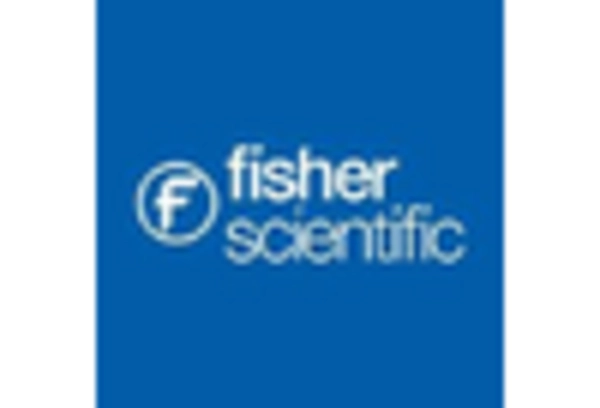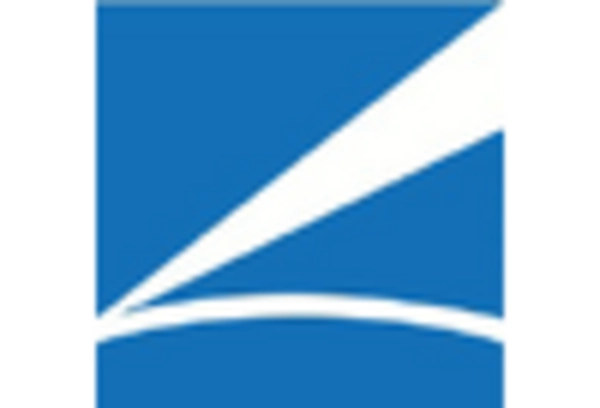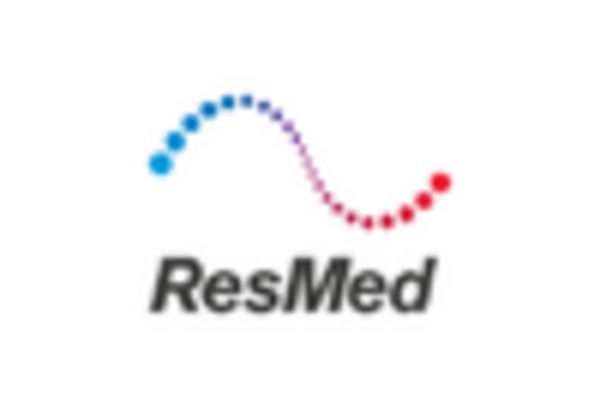Growing Geriatric Population
The aging population is a significant demographic factor contributing to the expansion of the Sleep Related Hypoventilation Market. As individuals age, the likelihood of developing sleep-related disorders increases, with studies indicating that nearly 50% of older adults experience sleep disturbances. This demographic shift necessitates targeted healthcare solutions, including diagnostic tools and treatment options specifically designed for older patients. The increasing life expectancy and the associated rise in chronic health conditions further exacerbate the prevalence of sleep hypoventilation among the elderly. Consequently, healthcare systems are likely to allocate more resources towards addressing these issues, thereby fostering growth in the Sleep Related Hypoventilation Market.
Rising Prevalence of Sleep Disorders
The increasing prevalence of sleep disorders, particularly sleep apnea and hypoventilation, is a primary driver for the Sleep Related Hypoventilation Market. According to recent studies, approximately 30% of adults experience some form of sleep disorder, with a significant portion suffering from hypoventilation-related issues. This growing incidence necessitates effective diagnostic and therapeutic solutions, thereby propelling market growth. As awareness of the health implications associated with untreated sleep disorders rises, healthcare providers are more likely to recommend interventions, further stimulating demand within the Sleep Related Hypoventilation Market. The correlation between sleep disorders and comorbidities such as obesity and cardiovascular diseases also underscores the urgency for effective management strategies, which could lead to an expansion of the market.
Advancements in Treatment Technologies
Technological innovations in treatment modalities for sleep-related hypoventilation are significantly influencing the Sleep Related Hypoventilation Market. The development of advanced continuous positive airway pressure (CPAP) devices, adaptive servo-ventilation, and other non-invasive ventilation techniques has improved patient compliance and outcomes. These advancements not only enhance the effectiveness of treatments but also broaden the range of options available to patients. Market data indicates that the introduction of smart devices with integrated monitoring capabilities is likely to attract a tech-savvy demographic, thereby expanding the market. Furthermore, the ongoing research into personalized medicine and tailored therapies may lead to more effective interventions, which could further drive growth in the Sleep Related Hypoventilation Market.
Increased Focus on Preventive Healthcare
The growing emphasis on preventive healthcare is reshaping the landscape of the Sleep Related Hypoventilation Market. As healthcare providers and patients alike recognize the importance of early intervention, there is a shift towards proactive management of sleep disorders. This trend is reflected in the rising demand for screening programs and educational initiatives aimed at identifying sleep-related hypoventilation early. Market data suggests that investments in preventive measures can lead to reduced healthcare costs in the long run, as timely interventions can mitigate the risk of severe complications associated with untreated sleep disorders. This proactive approach is likely to enhance the overall market for sleep-related interventions, including those targeting hypoventilation.
Integration of Sleep Medicine into Primary Care
The integration of sleep medicine into primary care practices is emerging as a crucial driver for the Sleep Related Hypoventilation Market. As primary care physicians increasingly recognize the impact of sleep disorders on overall health, they are more likely to screen for and address sleep-related hypoventilation. This shift not only facilitates earlier diagnosis but also encourages a more holistic approach to patient care. The collaboration between sleep specialists and primary care providers is expected to enhance treatment accessibility and patient outcomes. Market trends indicate that this integration could lead to a substantial increase in the number of patients receiving appropriate interventions, thereby expanding the Sleep Related Hypoventilation Market.


















Leave a Comment